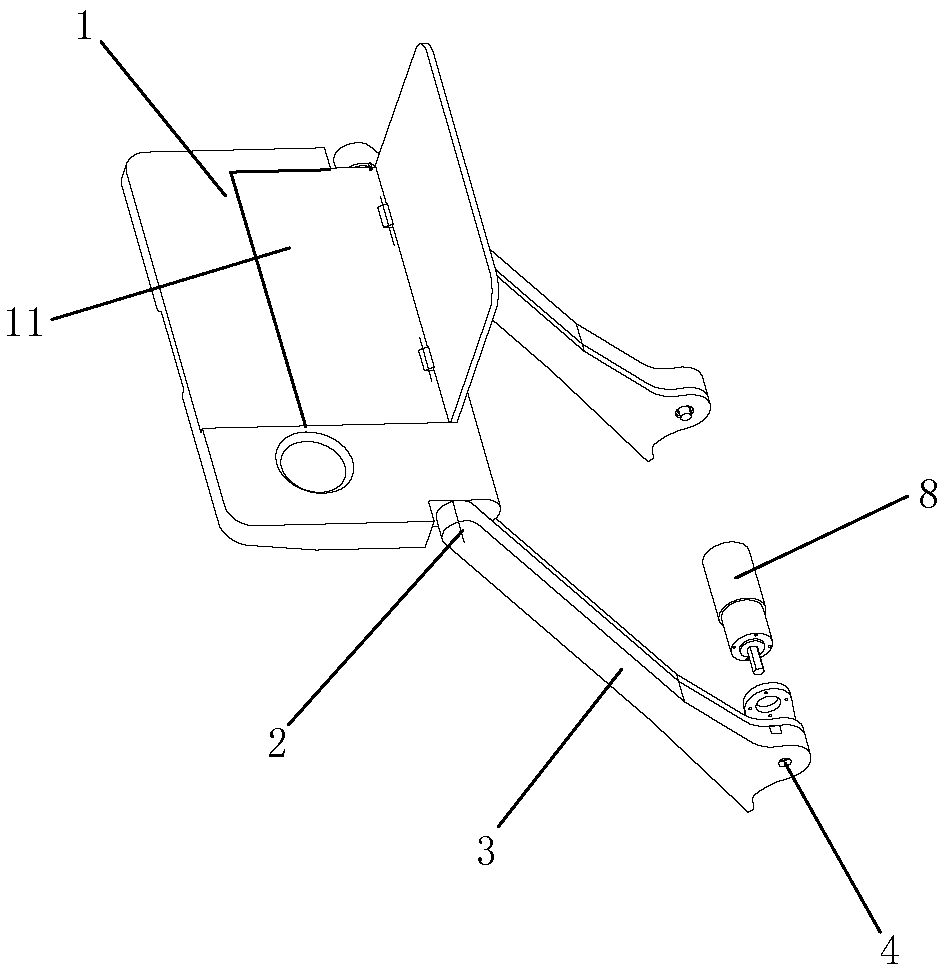Method for preventing colliding dining table board during rotation of rail traffic passenger car seat, and electric dining table board
A rail transit and electric dining table technology, which is applied to seats, railway car body parts, transportation and packaging, etc., can solve the problems of table board window seat collision, high work intensity, and small space, so as to shorten the reversing time and reduce the Labor and operating costs, the effect of easy repair and maintenance
- Summary
- Abstract
- Description
- Claims
- Application Information
AI Technical Summary
Problems solved by technology
Method used
Image
Examples
Embodiment 1
[0029] In the method for preventing the rail transit bus seat from colliding with the dining table when the seat is rotated in this embodiment, before the seat is rotated, a detection device is used to detect whether the dining table on the rear side of the seat is retracted, and if it is not retracted, the driving device is used to drive the dining table to the opposite direction. Stow the back of the chair, and then use the locking device to lock it on the back of the chair, then turn the seat, and continue to monitor whether the dining table leaves the back of the chair during the turning process, and stop turning the seat if the dining table leaves the back of the chair And sound the alarm. On the one hand, the method can detect whether the dining table board is put away for processing, and on the other hand, prevents the dining table board from leaving the chair back during the rotation process of the seat. In the prior art, the position detection, automatic storage, and ...
Embodiment 2
[0035] like figure 1 , figure 2 Shown, a kind of electric table board is used for the method for preventing rail transit passenger car seats from colliding with the table board when rotating, and it includes a table board 1, a first rotating shaft 2, a support arm 3, a second rotating shaft 4 and a The dining table board 1 is locked on the locking knob 5 on the back side of the chair. The dining table board 1 is rotatably connected to one end of the support arm 3 through the first rotating shaft 2. The first transfer 2 support arm 3 and the second transfer 4 are both two. The other end of the support arm 3 is rotatably connected to the back of the chair through the second rotating shaft 4, and also includes a detection device for detecting whether the dining table 1 is received on the back of the chair, and drives the dining table 1 toward the chair. The driving device, the knob motor 6 and the alarm that the back is retracted, the detection device includes a position senso...
Embodiment 3
[0043] like image 3 As shown, this embodiment provides another driving device for driving the dining table 1 to be retracted towards the back of the chair. Specifically, on the basis of Embodiment 2, the driving device further includes a synchronous belt 91, and the synchronous belt One end of 91 is drivenly connected with the first rotating shaft 2 through the first synchronous wheel 92, and the other end of the synchronous belt 91 is connected with the output end of the second rotating shaft 4 and the turning motor 8 through the second synchronous wheel 93 , the timing belt 91 is arranged in the support arm 3 , and in this embodiment, the timing belt 91 drives the table board 1 to rotate relative to the support arm 3 . As another embodiment, a motor may also be provided at the first rotating shaft 2 to drive the table board 1 to rotate.
[0044] Other technical features of this embodiment are the same as those of Embodiment 2, and will not be repeated here.
PUM
 Login to View More
Login to View More Abstract
Description
Claims
Application Information
 Login to View More
Login to View More - R&D
- Intellectual Property
- Life Sciences
- Materials
- Tech Scout
- Unparalleled Data Quality
- Higher Quality Content
- 60% Fewer Hallucinations
Browse by: Latest US Patents, China's latest patents, Technical Efficacy Thesaurus, Application Domain, Technology Topic, Popular Technical Reports.
© 2025 PatSnap. All rights reserved.Legal|Privacy policy|Modern Slavery Act Transparency Statement|Sitemap|About US| Contact US: help@patsnap.com



